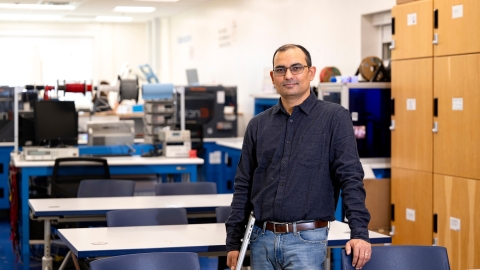
Rajesh Kumar, Computer Science
February 23, 2024
"Are behavioral biometrics systems biased toward different demographics? Are they robust enough to withstand sophisticated attacks and secure private information? These are the questions I am attempting to answer with my students here at Bucknell."
Technology is such a ubiquitous part of modern life that our devices often serve as extensions of our physical selves. In fact, many of us have already linked our unique physical characteristics to our phones and laptops, with fingerprint scanning and facial recognition constituting widely adopted methods for enhancing device security. These physical biometrics, however, are not infallible. Instead, the future of biometrics could lie in how we interact with our devices, says Professor Rajesh Kumar, computer science.
"The way you walk, the way you talk, the way you swipe, and the way you type — sensors in smart devices can capture all of these behaviors that humans produce," says Kumar. "My research focuses on how data recorded by smart devices can be used to design, implement, and evaluate systems that solve human-centered problems."
While convenient, physical biometrics-based identity verification systems have serious limitations. For example, they are susceptible to spoofing attacks and biased against darker skin tones. On the other hand, behavioral biometrics, which analyze the distinctive habits of how we interact with our devices, such as swiping on our phones or typing on our keyboards, offer continuous user identity monitoring in the background.
"Are behavioral biometrics systems biased toward different demographics? Are they robust enough to withstand sophisticated attacks and secure private information? These are the questions I am attempting to answer with my students here at Bucknell," says Kumar.
After earning his master's degrees in computer applications and mathematics, Kumar completed his doctorate at Syracuse University, where he started to develop his research with behavioral biometrics. His most recent research study examined how to detect fake social media profiles by analyzing users' typing patterns. By collecting and analyzing data from various social networks, he and his student researchers were able to ascertain how keystroke biometrics could be utilized to authenticate and secure accounts, detect fraudulent activity, and identify individuals who share fake news stories or hateful content online.
Behavioral biometrics holds great potential for improving security online, but Kumar is also interested in how biometrics could be used to promote physical well-being offline. Wearable technology, such as smartwatches, can monitor vital signs and stress levels, detect seizures and falls, and track the progress of Parkinson's disease.
The same questions that animate Kumar's work in the lab undergird his work in the classroom, where his students are researching the trustworthiness of behavioral biometric systems. Including his students in this kind of work provides an opportunity to teach them crucial skills, like designing data collection protocols and analyzing datasets, that will serve them in future careers in the rapidly evolving market for data scientists. Research that examines biases in data also teaches students to consider the roles that science and technology play in building a fair and equal society.
"Student questions always inspire new research ideas and novel ways of thinking about familiar problems," says Kumar. "The classroom is the ideal space to ask the kinds of questions that can deepen your understanding of the topic and encourage collaborative discussions that lead to potential solutions."

